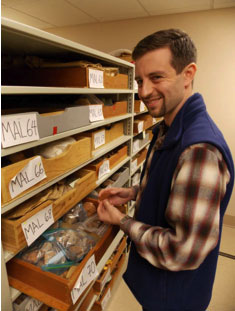In my previous entries for this blog I have mostly focused on the fieldwork aspects of archaeology, particularly my and my peers’ travels in Africa during the summer field season. For archaeologists studying human origins, Old World fieldwork is an integral part of our jobs, but today I am recently returned from a different type of research travel – the equally important, if less sexy, museum research trip.
During the last week of November I spent three days in the collections of the Stone Age Institute (SAI) in Bloomington, Indiana studying artifacts excavated nearly 50 years ago in northern Malawi by one of the godfathers of African archaeology: J. Desmond Clark. An astonishingly prolific fieldworker and great synthesizer of archaeological research, roughly 10 years after his death, Clark’s legacy lives on not just through the numerous students he trained over his long career but through the archaeological assemblages that now populate the collections of SAI and others institutions. Revisiting assemblages excavated and analyzed decades ago is a rewarding and very necessary part of archaeology; new analytical and dating technologies allow researchers to gain insights and draw conclusions that simply were not possible previously (more on that later). But there is more to the experience of studying a museum collection than the tangible (and publishable) benefits.
An artifact in a collection has three distinct histories; the first is its pre-depositional history –who made it, how, where, and why? The second is post-depositional; when did it enter the archaeological record, what natural processes acted on it since being buried, and how has it been altered as a result? The third and most recent history is post-excavation; who found it, how was it recovered, how has it been analyzed since, and which individuals or museums have curated it over the years? There is something visceral in the experience of looking through collections which preserve artifacts of the excavators as well as the excavated material itself.
Although most artifacts at SAI have neatly written or typed labels and are stored in sturdy plastic bags, the drawers also contain frequent traces of the people who first brought the artifacts to light. Cardboard cigarette boxes bearing the tax stamp of Southern Rhodesia (today’s Zimbabwe) are a ready reminder of the world in which Clark and his colleagues did their early research, a world where much of Africa was still divided into European colonies. The notes penciled on many such boxes also serve as proof that J.D. Clark’s handwriting would have put the prescription pad of many a medical doctor to shame; no wonder that his wife and longtime collaborator Betty is rumored to have been the only one capable of reading his field journals with ease. Twenty-five year old Post-It notes mentioning which tools were to be photographed for a thesis or who someone should contact with questions about refitting stone flakes attest to the work of the graduate students who came before me. They serve as a reminder that artifacts, however old, aren’t lifeless stone; they continue to interact with the world through the people who study them.
As the most recent visitor to the Chaminade 1A collection from Karonga, Malawi, I obtained samples of ochre artifacts for geochemical analysis and used a reflectance spectrometer to measure the color of the ochre pigment. Figuring out where the Middle Stone Age inhabitants of northern Malawi obtained their ochre and if they were deliberately selecting specific colors of pigment are central questions of my dissertation research. As I finished my work at SAI on this past Thursday afternoon I took stock of my effect on the collection; there will be permanent traces of my visit, most notably the small drill holes which were a necessary part of my geochemical sampling procedure. My own handwritten labels and notes that now accompany those artifacts indicate how to get in touch with me if any future visitors have questions about the procedure used to extract powdered ochre or why any such, even minimally destructive, sampling was necessary. Ideally, the entire curation history of an artifact should be readily available from the institution housing it; for this reason I will be submitting a report to SAI documenting all of my methods along with before and after photographs of the artifacts that I sampled. But even the most thorough documentation cannot replace the personal experience of opening an old wooden drawer in a basement in the heartland of America and smelling the petrichor of northern Malawi at the end of the dry season.


